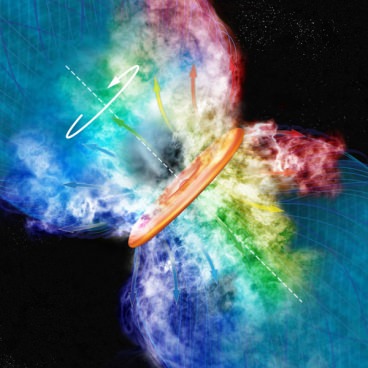It has been difficult for astronomers to see how massive stars form, since these stars are rare, form quickly and tend to be enshrouded in dense, dusty material which obscures them from view. But astronomers using the Very Long Baseline Array (VLBA) radio telescope were able to take images of the wavelengths of light emitted by a massive young star located 1,350 light years away in the Orion constellation. The created a ‘movie’ from the data, which they say shows the first evidence that young massive stars form from an accretion disk, just as smaller stars form.
“It is the first really ironclad confirmation that massive young stars are surrounded by orbiting accretion disks, and the first strong suggestion that these disks launch magnetically driven winds,” said Mark Krumholz, from the University of California at Santa Cruz.
The astronomers, led by Lynn D. Matthews from the Haystack Observatory at MIT, were able to see a disk of gas swirling close to the young massive star, known as Source I (said like “Source Eye”) in the high-resolution time-lapse movie they created.
By assembling 19 individual images of Source I taken by the VLBA at monthly intervals between March 2001 and December 2002, the high-resolution movie reveals thousands of masers, radio emitting gas clouds that can be thought of as naturally occurring lasers, located close to the massive star. According to Matthews, only three massive stars in the entire galaxy are known to have silicon monoxide masers. Because the silicon monoxide masers emit beams of intense radiation that can pierce the dusty material surrounding Source I, the scientists could probe the material close to the star and measure the motions of individual gas clumps.
Click here to see the time-lapse movie.
For almost 20 years, astronomers have known that low-mass stars form as a result of disk-mediated accretion, or from material formed from a structure rotating around a central body and driven by magnetic winds. But it had been impossible to confirm whether this was true for massive stars, which are eight to 100 times larger than low-mass stars. Without any hard data, theorists proposed many models for how massive stars might form, such as via collisions of smaller stars.
“This work should rule out many of them,” Krumholz said.
Because massive stars are believed to be responsible for creating most of the chemical elements in the universe that are critical for the formation of Earth-like planets and life, understanding how they form may help unravel mysteries about the origins of life.
The VLBA consists of a network of 10 radio telescope dishes located across North America, and can be thought of as a virtual telescope 5,000 miles in diameter. Used as a zoom lens to penetrate the dusty cloud surrounding the massive star, the VLBA captured images up to 1,000 times sharper than those previously obtained by other telescopes, including NASA’s Hubble Space Telescope.
The team’s paper was published in the Jan. 1 issue of the Astrophysical Journal.
Lead image caption: Artist’s conception of the rotating disk of hot, ionized gas surrounding Orion Source I, blocking the star from our view. A cool wind of gas is driven from the upper and lower surfaces of the disk and is sculpted into an hourglass shape by tangled magnetic field lines. Image: Bill Saxton, National Radio Astronomy Observatory/Associated Universities, Incorporated/National Science Foundation
Source: MIT


Stunning, you can see the rotation. This greatly enhances our knowledge of star formation.
Interesting to see the rotation expressed as red on one side and blue on the other side of both lobes.
What would be way cool, would be to detect right handed chirality molecules exiting one pole and left handed chirality molecules exiting from the other!